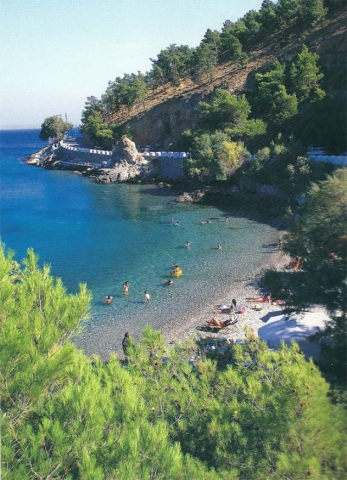Press here.
Places near Beach
The beach Kasonia is the closest one to Pothia and is located on the road towards the beach Therma, behind the harbor.
It is a long sandy beach, with a few trees on its coast that provide natural shade to bathers.
It is preferred by families with children and also by the inhabitants of Pothia, due to its easy access from the city.
There are sunbeds and umbrellas for hire, changing rooms, beach bars and some restaurants.
The beach Akti (which literally means 'coast') is on the east side of Kalymnos. You can get there by car, along the road which connects Pothia to Vathys.
It's a nice beach, with fine sand and clear waters. A tavern next to it serves the hungry guests and bathers.
Pothia is the capital and also the port of Kalymnos. The construction of Pothia began in early 1850, when pirate raids started to occur less and less often. As a result, the people who lived by then in the Castle of Chora, seeking for protection against the pirates, began progressively to build their homes out of the Castle.
The houses are built in amphitheatrical formation, facing the sea, and are separated from each other by narrow alleys. As you walk in them, you can witness the Italian influence and also the clearly visible details of neoclassical architecture on the traditional buildings. Most traditional houses are encountered in the districts Ypapandi, Hevangelistria, Agios Theologos and Patithries.
Today, Pothia is the administrative and commercial center of the island, where you will find all the public services such as the police, the post office, the port authority, the hospital etc. There are also many facilities for visitors, such as taverns, restaurants, cafes, bakeries and hotels.
In Pothia, you can visit the Archaeological Museum of Kalymnos, which presents the history of the island and hosts various treasures that have been occassionally retrieved from the bottom of the sea, and the Nautical Museum, which presents everything related to the great Kalymnian maritime activity and the sponge catching, with exhibits from ancient shipwrecks ships.
Another interesting venue in Pothia is the Vouvalis' family Mansion, where you will get a taste of the Kalymnian urban architecture.
In Pothia's waterfront, it is placed the Cathedral of the Transfiguration of Jesus Christ. Over there, it is worth seeing the magnificent marble temple, which was crafted by the great Greek sculptor Giannoulis Chalepas. Many churches in Pothia and Kalymnos in general, are adorned with works of great Kalymnianpainters such as S. Magglis, M. Alahouzos, G. Economou, T. Kourounis, N. Maggos, T. Billiris, E. Choulis. and S. Pizanias.
Several beaches are found close to Pothia, one of them being Therma, an area of hot springs that have healing properties.
The beach Gefira is next to Therma and is one of the main beaches of Pothia.
It is a small but beautiful beach with pebbles, rocks and vegetation. The sea water is turquoise and very clean.
Vathys or Vathy, is situated 11 km northeast of Pothia, in the middle of the biggest and most fertile valley of Kalymnos.
The combination of the cove with the -full of citrus- valley, form a landscape of extraordinary beauty which has been likened to a fjord.
At the port of Rina, in Vathys, there is a shipyard and a safe anchorage which serves the tourist yachts. Next to the port of Rina you will find a natural aquarium, a definitely worth seeing attraction.
There are also hotels, taverns and cafes, where you can savor traditional dishes, seafood in particular.
You can enjoy nice walks and rides in the beautiful nature. You may also visit archaeological sites that lie around, such as the prehistoric cave Daskalio, which is located at the entrance of the harbor of Rina.
From there, you can board on or rent a boat that will take you to the more distanct beaches of the island (e.g. Mikres Almyres, Megales Almyres and Pezoda)
Megales Almyres is a pure beach in Kalymnos' eastern coast that can be reached only by boat.
You can go there either by boarding on a boat that makes an organized tour of the island and stops at Megales Almyres for a plunge, or by renting a boat from the port of Rina, if you desire more privacy.
The beach is completely virgin and lacks therefore any kind of infrastructure for bathers or visitors. As a consequence, if you decide to visit Megales Almyres you should carry with you all the necessary supplies (mainly water and a means of shading).
The beach Arginoda is situated on the northwest coasts of Kalymnos, at 16.5 km away from Pothia.
The crystal clear turquoise waters, the rounded pebbles and trees that surround Arginoda bay create a beautiful landscape.
In Arginoda you can find umbrellas and sunbeds. In the broader area, there are several restaurants, hotels and lodgings.
The beach Sikati lies inside a closed bay, which is essentially a natural fjord. It's a small, sandy beach, with some pebbles and crystal clear waters.
You can access it by sea, riding a boat from Vathys, or a through a rough path from the Palionisos Cove.
There is virgin of human constructions, so it is recommended that visitors ensure their essential supplies (mainly water).
Arginoda is a really picturesque village, 17 Km away from the port of Kalymnos. It is built around a deep bay, where there is a lovely organized beach and several taverns.
It is recommended to visit the church Panagia ton Arginodon (Virgin Mary of Arginoda), which also bears the nickname 'Galatiani', as it is considered the protector of shepherds of the regions Arginonta, Skalia and Emborios.
In there, you can also see the restored olive press of Panagia Galatiani, which is the oldest one in Kalymnos island.
Palionisos Bay is on the east coast of Kalymnos, near Vathys. You will arrive there either by boat or after taking the new road from Skalia to Palionisos.
The beach is shingle and the water is clean. There is also a small dock that serves the fishing boats. There are also some tavernas by the beach.
The archaeological Museum of Kalymnos is housed in the 19th c. mansion of the Vouvalis family, who were sponge fishers. It was built in the mid 19th c. and inaugurated in 1894. The dining room has been reconstructed with the dinner service, the living-room, the office with the commercial correspondence, the service rooms, the storerooms and the photographic archives, complete with all the furniture and family household objects.
Because of the lack of space, the archaeological collection will be moved to a specially organized building. The future display will include figurines, pottery and coins of the Archaic, Classical and Hellenistic periods (7th-1st c. BC) from the necropolis in the Damos district and the depository of the naiskos of Apollo Dalios.
The Museum contains the following collections:
Prehistoric collection, comprising pottery, figurines and tools from the Neolithic, Minoan and Mycenaean periods.
Classical collection, comprising pottery, inscriptions, figurines and sculptures, chiefly of the Hellenistic period.
Reconstruction of the interior of a 19th c. mansion, including the dining room, living-room, storerooms, service rooms and photographic archives of the Vouvalis family.
Private Vouvalis archaeological collection, comprising pottery, lamps and small objects, chiefly of the Hellenistic period.
http://odysseus.culture.gr/h/1/eh151.jsp?obj_id=3441
Vlychadia is located in the southern part of Kalymnos, just 5 kilometers away from the capital Pothia. The beautiful seaside scenery, the wonderful beaches and the plethora of traditional tavernas and cafes will ensure your beautiful moments of relaxation and recreation.
In Vlychadia you can visit the privately owned Marine Life and Findings Museum, where you will see exhibits relative to sponge catching and various objects from the depths of the Mediterranean.
It is also worth visiting the Kefalas cave (or 'Cave of Zeus'), the most beautiful cave of Kalymnos, located only two kilometers southwest of Vothynoi. Sea trips are held daily to the cave, by boats that depart from the port of Pothia. Alternatively you can go to the cave by following the path that passes in front of the Monastery of St. Catherine.






